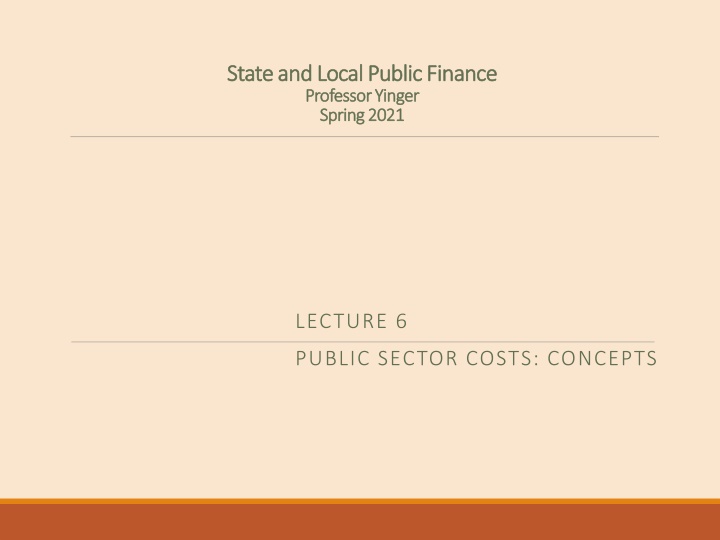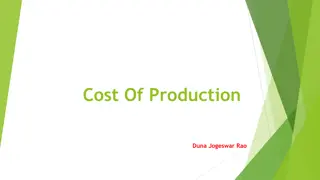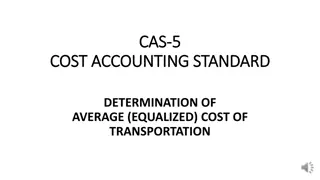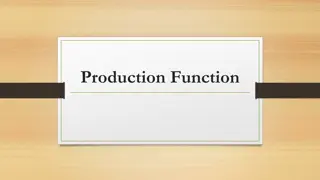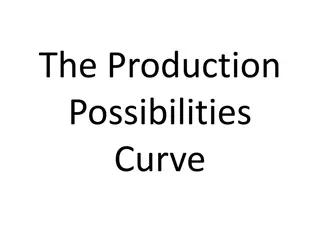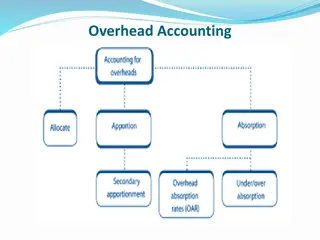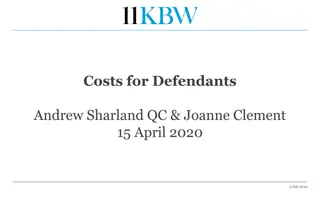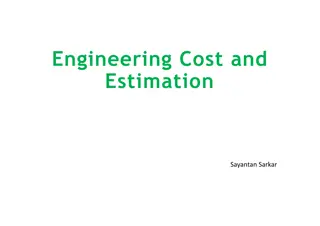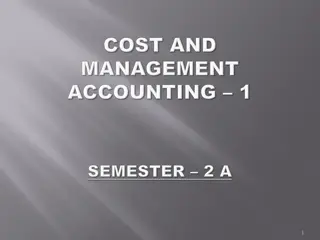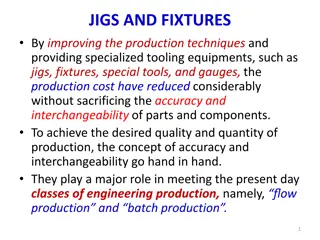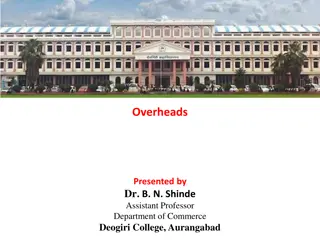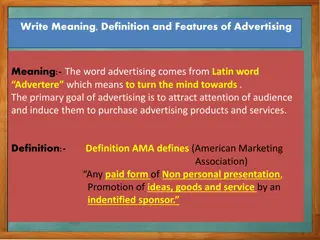Public Sector Costs: Production and Cost Concepts
This lecture covers key concepts in public sector costs, focusing on production functions and cost functions that determine the spending needed to achieve a desired level of output. Understanding these concepts is essential for analyzing public spending and performance in state and local finance.
Download Presentation

Please find below an Image/Link to download the presentation.
The content on the website is provided AS IS for your information and personal use only. It may not be sold, licensed, or shared on other websites without obtaining consent from the author.If you encounter any issues during the download, it is possible that the publisher has removed the file from their server.
You are allowed to download the files provided on this website for personal or commercial use, subject to the condition that they are used lawfully. All files are the property of their respective owners.
The content on the website is provided AS IS for your information and personal use only. It may not be sold, licensed, or shared on other websites without obtaining consent from the author.
E N D
Presentation Transcript
State and Local Public Finance State and Local Public Finance Professor Yinger Professor Yinger Spring 2021 Spring 2021 LECTURE 6 PUBLIC SECTOR COSTS: CONCEPTS
State and Local Public Finance State and Local Public Finance Lecture 6: Public Sector Costs: Concepts Lecture 6: Public Sector Costs: Concepts Section Outline This is the first of three classes on public sector costs o1. Production and Cost Concepts o2. Policies to Lower Costs o3. Case: Privatization These classes are about the technology of public production.
State and Local Public Finance State and Local Public Finance Lecture 6: Public Sector Costs: Concepts Lecture 6: Public Sector Costs: Concepts Class Outline Public Production and Cost Functions The Role of the Environment Public Expenditure Functions The Role of Efficiency
State and Local Public Finance State and Local Public Finance Lecture 6: Public Sector Costs: Concepts Lecture 6: Public Sector Costs: Concepts Class Outline Public Production and Cost Functions The Role of the Environment Public Expenditure Functions The Role of Efficiency
State and Local Public Finance State and Local Public Finance Lecture 6: Public Sector Costs: Concepts Lecture 6: Public Sector Costs: Concepts Key Concepts Production functions translate inputs into outputs. Cost functions indicate the spending required to reach a given level of output. Understanding public production and cost functions is critical to understanding public spending and performance.
State and Local Public Finance State and Local Public Finance Lecture 6: Public Sector Costs: Concepts2 Lecture 6: Public Sector Costs: Concepts2 Private Production and Cost Private Production Function Q = q{Inputs} Private Cost Function C = c{Q, Input Prices}
State and Local Public Finance State and Local Public Finance Lecture 6: Public Sector Costs: Concepts Lecture 6: Public Sector Costs: Concepts Government Production Function (Bradford/Malt/Oates, National Tax Journal 1969) Intermediate Output (G depends on inputs) G = g{Inputs} Final Output (S depends on G and the Environment, N) S = s{G, Environment} = s{G, N} Inverted Final Output (required G depends on N and on desired S) G = s-1{S, N}
State and Local Public Finance State and Local Public Finance Lecture 6: Public Sector Costs: Concepts Lecture 6: Public Sector Costs: Concepts Government Cost Functions (B/M/O, NTJ 1969) Cost of Intermediate Output (depends on G and input prices, W) CG = cG{G, W} Cost of Final Output (depends on S, N, and W) C = c{G needed for S, W} = c{s-1{S, N}, W} = c {S, N, W}
State and Local Public Finance State and Local Public Finance Lecture 6: Public Sector Costs: Concepts Lecture 6: Public Sector Costs: Concepts Public Outputs Public cost functions focus on the cost of government performance. o Police: Crime rate. o Fire: Probability of loss from fire. o Education: Test scores, graduation rates. Public cost functions are influenced by the environment in which the services are delivered.
State and Local Public Finance State and Local Public Finance Lecture 6: Public Sector Costs: Concepts Lecture 6: Public Sector Costs: Concepts Examples of Environment Police: Poor people are more likely to be victims of crime and to be desperate enough to turn to crime. Fire: Old houses catch fire more often and burn faster; fire spreads faster when housing is closely packed. Education: Children from poor families are more likely to bring health or behavioral problems to school, and less likely to have lessons reinforced at home.
State and Local Public Finance State and Local Public Finance Lecture 6: Public Sector Costs: Concepts Lecture 6: Public Sector Costs: Concepts Estimates of Environment Ladd & Yinger (America s Ailing Cities 1991) find that police costs increase with poverty and city population. Duncombe & Yinger (Journal of Public Economics 1993) find that fire costs increase with industrial and utility property and tall buildings. Many scholars find that education costs increase with the share of students from poor families or with limited English proficiency. (See, for example, Duncombe and Yinger, Economics of Education Review 2005).
State and Local Public Finance State and Local Public Finance Lecture 6: Public Sector Costs: Concepts Lecture 6: Public Sector Costs: Concepts Estimated Pupil Weights (=extra costs for at-risk pupils) Pupil- Weighted Average Simple Average Directly Estimated Without Special Education Child Poverty 1.415 1.491 1.667 LEP 1.007 1.030 1.308 With Special Education Child Poverty 1.224 1.281 1.592 LEP 1.009 1.033 1.424 Special Education From: Duncombe/Yinger EER 2005 2.049 2.081 2.644
State and Local Public Finance State and Local Public Finance Lecture 6: Public Sector Costs: Concepts Lecture 6: Public Sector Costs: Concepts Duncombe/Yinger Study of California (International Tax and Public Finance 2011) Cost factors in education oShare of student from poor families oShare of students with limited English proficiency oShare of students with a severe disability oRequired wage to attract teachers oEnrollment (economies of scale) oEnrollment change oGrade level (higher costs for high school)
State and Local Public Finance State and Local Public Finance Lecture 6: Public Sector Costs: Concepts Lecture 6: Public Sector Costs: Concepts The Environment and the Public Cost of Living. Everyone knows that it takes a higher salary to reach a given standard of living when the cost of living is higher. The same goes for public costs: It takes more government spending to achieve a given level of public services when the environment is hasher. An equivalent statement is that it takes more government spending to achieve a given level of public services when governmental costs are higher based on factors, such as poverty, outside a government s control.
State and Local Public Finance State and Local Public Finance Lecture 6: Public Sector Costs: Concepts Lecture 6: Public Sector Costs: Concepts Questions What is a public production function? What is a public cost function? What is the environment in a public cost function? How is a public cost function like a cost-of-living adjustment?
State and Local Public Finance State and Local Public Finance Lecture 6: Public Sector Costs: Concepts Lecture 6: Public Sector Costs: Concepts Class Outline Public Production and Cost Functions The Role of the Environment Public Expenditure Functions The Role of Efficiency
State and Local Public Finance State and Local Public Finance Lecture 6: Public Sector Costs: Concepts Lecture 6: Public Sector Costs: Concepts Cost versus Spending A cost function describes technology, and implicitly is based on best practices. In fact, however, we cannot observe costs, we can only observe spending. The final step in the logic is to link costs and spending.
State and Local Public Finance State and Local Public Finance Lecture 6: Public Sector Costs: Concepts Lecture 6: Public Sector Costs: Concepts Government Expenditure Functions To link cost (C) and spending (E), we can write: E = C/e = c{S, N, W}/e Definition of Efficiency (e) o An efficient government (e = 1) uses best practices to spend as little as possible in delivering S. o Spending more than this minimum (e < 1) is inefficient. o Alternative measures of S yield alternative definitions of e.
State and Local Public Finance State and Local Public Finance Lecture 6: Public Sector Costs: Concepts Lecture 6: Public Sector Costs: Concepts Examples of Efficiency Suppose we define S as student performance on basic math and reading tests. Many rich, suburban schools will be inefficientin delivering this S despite their high scores because they spend a lot on art, music, science, and social studies. This inefficiency is not inherently bad, but it affects the outcomes of accountability programs designed to boost math and reading. Some poor, urban schools will be efficientdespite their low scores because they focus most of their spending on the basics. Some schools also may be inefficient because they are wasteful a type of inefficiency that cannot be separated from the above.
State and Local Public Finance State and Local Public Finance Lecture 6: Public Sector Costs: Concepts Lecture 6: Public Sector Costs: Concepts Measuring Efficiency Efficiency cannot be measured directly. Scholars disagree on the best way to account for efficiency in estimating an expenditure function. One method (D/Y): oThe efficiency-related behavior of voters (monitoring, demand for public services not in S) and public officials (waste) responds to incentives. oControl for variables that describe these incentives.
State and Local Public Finance State and Local Public Finance Lecture 6: Public Sector Costs: Concepts Lecture 6: Public Sector Costs: Concepts Examples of Incentives That May Influence Efficiency Tax Price: Voters monitor public officials more carefully when paying a higher share of tax revenue. State Aid: State aid shifts the financing burden away from voters and weakens their incentive to monitor public officials. Competition: Public officials may be more efficient when they face competition.
State and Local Public Finance State and Local Public Finance Lecture 6: Public Sector Costs: Concepts Lecture 6: Public Sector Costs: Concepts Duncombe/Yinger Study of California Efficiency factors in education (with state s test score index as the measure of performance) oMedian income oTax price (based on parcel tax) oState aid for education oFederal aid for education oMigration into district oCategorical aid as a share of total aid
State and Local Public Finance State and Local Public Finance Lecture 6: Public Sector Costs: Concepts Lecture 6: Public Sector Costs: Concepts Other Recent Cost Studies New York: Eom, Duncombe, Nguyen-Hoang, and Yinger, Education Finance and Policy, Fall 2014. Massachusetts: Nguyen-Hoang and Yinger. Journal of Education Finance, Spring 2014. Missouri: Duncombe and Yinger, Peabody Journal of Education, 2011. California, Kansas, Missouri, and New York: Lukemeyer, Duncombe, and Yinger. In Improving on No Child Left Behind, R. D. Kahlenberg (ed.), The Century Foundation, 2008. Literature Review: Duncombe, Nguyen-Hoang, and Yinger. 2015. Measurement of Cost Differentials. In Handbook of Research in Education Finance and Policy, 2nd Edition, M.E. Goertz and H.F. Ladd (eds.), New York: Routledge, 2015, pp. 260-278.
State and Local Public Finance State and Local Public Finance Lecture 6: Public Sector Costs: Concepts Lecture 6: Public Sector Costs: Concepts Allocative versus Productive Efficiency Note that we have defined two different efficiency concepts: oAllocative efficiency = whether goods and services are allocated to the people who value them most oProductive efficiency = whether goods and services are produced using best practices You can improve public welfare by boosting either type of efficiency!
State and Local Public Finance State and Local Public Finance Lecture 6: Public Sector Costs: Concepts Lecture 6: Public Sector Costs: Concepts Questions What does it mean to say that a local government is inefficient ? What is the difference between higher spending due to a local government s environment and higher spending due to inefficiency? How is the notion of governmental efficiency linked to the notion of governmental performance? How can a scholar account for efficiency in a study of local government spending?
